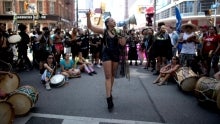After Pulse: Political Movements and the Dance Floor

“It’s gay pride, not black pride”—a spectator’s claim during the 2016 Toronto Pride Parade as quoted in the Globe and Mail—is emblematic of the vitriolic response to a brief sit-in by Black Lives Matter-Toronto (BLM) that halted one of the world’s largest Pride Parades for thirty minutes. Before ending their protest, BLM made nine demands of Pride’s organizers. Although over-shadowed by the more sensationalized request to curb police participation in Pride, six of BLM’s nine demands relate to fostering sites of music participation for LGBTQ people of color, including a call to reinstate a stage for South Asian music performance and additional funding for Blockorama, a dance music party for queer African diasporic people.
Such requests underscore that many queer people of color consider participation in music cultures to be vital to recognizing themselves as part of a larger community. To be sure, bodies listening and moving together on the dance floor can be evidence of queer lives and queer power. Historically, underground dance venues are spaces where queers can explore ideas of identity and community (see, for example, Fikentscher, Lawrence, Echols, Dyer).
BLM’s requests, then, seem to fit into the broader theme of the parade, in which participants honored the victims murdered at Pulse Nightclub in Orlando by carrying placards bearing the names and ages of victims and halting at 3PM to observe a moment of silence in their memory.
Unfortunately, public reactions to BLM’s demands suggest that music spaces in which queer people of color gather are understood as inconsequential to larger projects of LGBTQ politics—and that many Canadians still think of gayness as necessarily coupled with whiteness. Sue-Ann Levy, of the National Post, argued that this year’s parade was “in memory of the victims of the Orlando massacre” not “allowing one loud group to make a political statement.”

Photo by Mark Blinch - Canadian Press
Published responses, which ignore the intersection of race and sexuality and reify the hegemonic whiteness of LGBTQ narratives, are unsurprising given that these BLM activists comprise part of a long lineage of queer activists of color who have been erased from the stories we tell about LGBTQ politics. In fact, many attendees and participants at Toronto Pride may have been unaware of the fact that most people killed at Pulse were racialized Latinx queers.
What is lost in this discourse is that BLM’s protest is precisely what the massacre at Pulse requires of us: to make an aggressive stand for spaces in which queer people of color can amass as a collective under the pulsing rhythms of dance music and to recognize the political potential of such gatherings.
And as music scholars we must also teach the erroneousness of claims that these spaces can ever be disconnected from the social politics articulated by people of color.
The affective charge of queer collectivity is regularly predicated on black and latinx musical traditions and forms of social dance that come out of communities of color. Moments of togetherness on the dance floors at Toronto Pride 2016 were undeniably made possible by the labor, traditions, and genealogies of black and brown bodies. This should alter our understanding of these pasts, change how we conceptualize LGBTQ experience in the present, and enable more just collective visions for the future.
Queer music scholarship must lead this initiative and teach, widely and voraciously, how to hear these politics.
Biography
Craig Jennex is a Ph.D. Candidate in English & Cultural Studies and Gender Studies & Feminist Research at McMaster University in Canada. His recent published work can be found in Popular Music & Society, TOPIA: Canadian Journal of Cultural Studies and GUTS: A Canadian Feminist Magazine.





